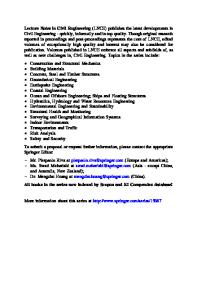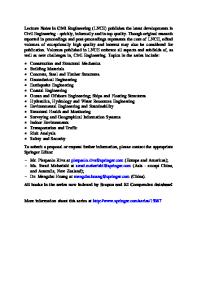Experimental Study on Dynamic Properties of UHMWPE and PVA Fibers Concrete
- PDF / 5,579,902 Bytes
- 19 Pages / 595 x 786 pts Page_size
- 50 Downloads / 316 Views
pISSN 1226-7988, eISSN 1976-3808 www.springer.com/12205
DOI 10.1007/s12205-020-2132-5
Structural Engineering
Experimental Study on Dynamic Properties of UHMWPE and PVA Fibers Concrete Bashir H. Osmana,b, Zhenghong Tiana,c, Guilin Jiangd, Xiao Sun
a
, and Adrianna Carrolle
College of Water Conservancy and Hydropower Engineering, Hohai University, Nanjing 210098, China Civil Engineering Department, College of Engineering, University of Sinnar, Sinnar 11174, Sudan c State Key Laboratory of Hydrology-Water Resources and Hydraulic Engineering, Hohai University, Nanjing 210098, China d Huanghe Surveying Planning& Designing Co. Ltd., Zhengzhou 450003, China e College of Civil and Transportation Engineering, Hohai University, Nanjing 21009, China a
b
ARTICLE HISTORY
ABSTRACT
Received 2 December 2019 Revised 29 March 2020 Accepted 13 May 2020 Published Online 20 August 2020
The purpose of this paper is to examine the dynamic three-point bending performance of UHMWPE and PVA fiber concrete specimens by means of density variation (0, 0.6, 1.2, 1.8, 2.4 kg/m3). Additionally, the difference in performance between UHMWPE and PVA fiber concretes, as well as the impact characteristics and the damage evolution law exhibited by these fiber concretes under repeated dynamic loading were studied and discussed. A Split Hopkinson pressure bar (SHPB) apparatus was used to determine the concrete behavior at different strain rates; the accuracy of which was achieved by conducting a structural transient dynamic response analysis. The dynamic failure strength and strain rate of the specimen were derived to investigate the rate effect with different quantities of UHMWPE and PVA fiber concretes. The experimental results were then compared with those predicted from available equations, verifying the validity of the results obtained. A theoretical model for analyzing the transient elastic response of the specimen was then proposed. This paper concludes by proposing an analytical equation for predicting the dynamic compression and tensile properties of these new-type fibers.
KEYWORDS Dynamics Polyethylene Fibers SHPB New-type fibers
1. Introduction As a common building material used in the industry, concrete is often subjected to dynamic loads during its service life. Both the compression and tensile behavior of concrete, are therefore considered vital parameters for evaluating the safety and stability of a concrete structure or building. Examples of such loads include; earthquakes, waves, water flow erosion, electromechanical equipment power and water hammer impact effects. Composites of fiber cement-based display advances structural performance and used in wide range in civil engineering construction. Ultrahigh molecular weight polyethylene (UHMWPE) fibers are considered as strong type of the available fibers, through their applications in different way and methods (van der Werff and Heisserer, 2016). The UHMWPE fiber contribution is very important especially in fiber-reinforced cementitious composites due to its high mechanic
Data Loading...











